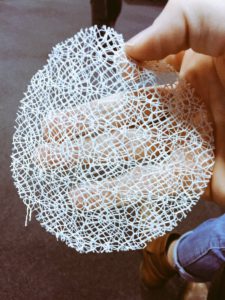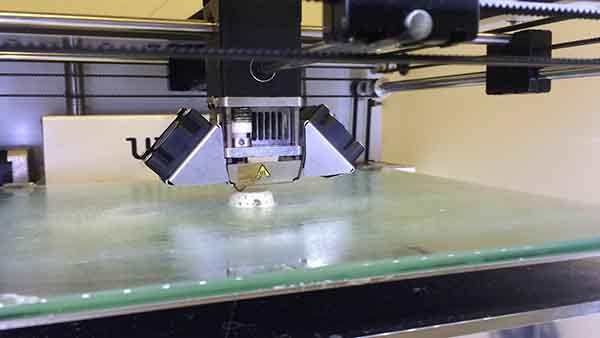Mat(t)isse: 3D Printing for Breast Reconstruction
Posted By Amandine Richardot on May 10, 2017 | 0 comments
Mat(t)isse developed a new technique for breast reconstruction, which uses lace and a 3D printed shell. This very innovative technique allows to personalize the implant and to avoid undergoing multiple surgeries. We had a talk with Julien Payen, co-founder of the project, about their path, their uses of 3D printing, and the implications of this new method, which are numerous and offer many benefits for women in need of breast reconstruction, but also for other types of surgeries.
Part 1 : Discovering Mat(t)isse
Sculpteo: Can you introduce your team to us?
Julien Payen: The 4 co-founders are me and three doctors from the CHU of Lille: the surgeon Pierre Guerreschi, and the biologists doctors Philippe Marchetti and Pierre-Marie Danzé. We all work directly together, with a steering committee meeting every two weeks. Two biological engineers also make part of the team, along with two interns: Marion who works on biomaterials, and Cesar, an intern in surgery who deals with implantations on animals. We are backed by the CHRU of Lille, and we have the chance to benefit from their tools (especially MRI), their operating rooms and their staff.
How was Mat(t)isse created?
Mat(t)isse comes from the encounter of these three doctors and me: Pierre Guerreschi, Philippe Marchetti and Pierre-Marie Danzé contacted me four years ago because they were searching for a textile material which could allow them to grow some fat. At that time, I was working in a textile competitiveness cluster, having initially a special background in textile.
Why were they looking for a fabric allowing to grow some fat?
To understand, you need to know what the two techniques of breast reconstruction that exist today are: the silicon implant and the fat transfer techniques like lipofilling. This last method was created twenty years ago. It consists in filling the empty areas with fat taken from the patient by liposuction. The problem is that if you put too much fat inside the implant, this fat necroses and disappears, and the patient has to undergo this surgery again, and regularly, which of course is not desirable.
That’s why these 3 doctors were looking for a material which could allow growing some fat, and for a technique to address the issues of the existing method. That’s where the Mat(t)isse project comes from.
How did you move from textile research to 3D printing?
We first made experiments with a textile material, a ‘classic’ lace, made with old-fashioned lace looms. This lace works really well to grow fat, but we needed a simple method for the surgeon, something he could do with just one intervention. To do so, we needed to give a 3D shape to the implant, and that’s where 3D printing became part of our project.
What becomes of the lace used and of the 3D printed shell?
The prosthesis (lace and shell) is entirely bio-resorbable. It is absorbed by the body, like stitches. After 6 months, the prosthesis is totally absorbed by the body, and the patient has a 100% natural boob, made of fat.
What are the advantages of this technique compared to the silicon implant?
The advantages of our technique are numerous:
- There’s only one surgery because the prosthesis is resorbable.
- The prosthesis can be personalized, which allows women who lost one or two boobs to get their previous body back.
- Reconstruction is natural, there is no foreign body in the long term.
- We also present a certain economical advantage because, with only one surgery, we globally reduce costs in the long term.
Moreover, the silicon implant technique can be risky: you might have heard of the PIP issue which occurred a few years ago. There were some manufacturing defects that had not been declared on some prosthesis, creating risks of breaking! Thousands of women had to remove their implants…
What is the explanation of your name, Mat(t)isse?
Well, there is a pun between Matisse and Lattice, but it is more subtle than that. Henri Matisse is a famous painter, coming from Cateau-Cambrésis (near Caudry). Matisse painted many nudes of women. The region of Caudry is famous for its lace leavers, which are behind our innovation and patent.
MAT(T)ISSE can also be found in the complete name of our process: MAtrices Textiles tridmiensionnelles synthétiques pour autogreffe de TISSus adipeux dédiées à la reconstitution tissulairE (Tridimensional synthetic textile matrices for adipose tissue autograft dedicated to reconstruction).
Part 2: Your use of 3D printing
What was your experience in terms of 3D printing before launching this project?
None!
What have you had to learn to use 3D printing? Which challenges related to this technology did you meet?
I mostly deal with the financial issues, and research and development strategy. As a result, I’m not directly dealing with 3D creation. We have an intern in charge of 3D modeling. But I still need to learn about this technology, and on the files. We’re learning how to make software. We work with partners, especially research centers in Belgium, which have experience in using scans of human bodies. We also use the picture library of the CHRU of Lille.
As for the challenges we met, we had some troubles at the beginning with bad 3D files which led to bad quality 3D prints. It has also been difficult to find the strands I already talked about. Today, our biggest issue is personalization.
Which advantage does 3D printing bring you compared to other manufacturing methods?
The other way to create the shell we imagined was injection. But the problem with injection is that you need to create a mold for each object, which is expensive and takes times. It doesn’t fit at all with the personalization we wish to offer.
How do you create the custom-made implant? What do you use to make your 3D file?
An MRI is always made before breast removal. It’s this 3D image that we use to create the volume and to create an STL file. The patient also has the possibility to tell us which shape she would like to give to her implant (it can be different from the shape of her former breast).
Which 3D printing technique, and which material do you use?
Our 3D printing material is a derived from Polylactic Acid (PLA), a medical grade thermoplastic which is frequently used for resorbable implants. This is a material that we often find in resorbable stitches. After all, before being a 3D printing material, PLA was already used for stitches in the 1960’s and 1970’s.
The 3D printing technology is FDM. We first used an Ultimaker 2, then a Dagoma. We just acquired a machine from the French company Pollen AM (PAM). This machine offers the advantage of using directly the material in the form of granules.
Indeed, the material that we use is medically certified and doesn’t exist in strands for the FDM printer, nor in powder for SLS printers. We receive it in granules, with prices from 2000 to 9000€/kg.
Do you consider starting mass production with 3D printing?
Yes, we created our startup LATTICE MEDICAL and we will industrialize our process. That’s why we need to use a machine which directly uses granules. Our long-term objective is to produce pieces in a cleanroom, that will be sterilized and then directly ready to be used by surgeons.
Part 3: Innovation & 3D printing in the medical sector
In how much time do you think your product will be available for the patients?
We’re still at the very beginning. Our first implantations, on animals, showed great results. Our tests have been very positive. We plan to raise funds for the first trimester of next year. From then, there is still one year and a half of research to make before finalizing the product: testing the speed of degradation of the prosthesis, the possibilities in terms of shape, the mechanical properties (if the person falls, how will the implant react to it?)… We need to make a complete study of the risks and to plan their management. And once all of that will be done, it will not be the end of the journey yet.
What will the next steps be?
Once research and development is finished and the risks are taken into account, we have to implement the processes required for industrialization: making the prosthesis in medical conditions and ensuring that our sterilization process meets the required conditions. The goal being to create the first 3D printing factory for soft tissues reconstruction in cleanroom! All of that should take one year more.
The next step will be the conception verification: testing products made in the factory on animals for 6 to 8 months. Then, we will have the right to start the tests on patients. So, in total, it will take at least 3 years before the product can be available for patients.
Do you imagine other applications of your technology?
We created this technology for breast reconstruction because it’s a well-known large-scale need. But it could work for any type of reconstructive implants for soft tissues: face, abdomen, bottom… This can also be used for plastic surgery.
We’re delighted to have shared the experience of Mat(t)isse with you. Although they already got a patent for their technology, obtained an international reward (the Theophile-Legrand price), and many people already talk about them, Mat(t)isse is still at the beginning of its adventure, and its progresses absolutely need to be followed! They will soon found their company, LATTICE MEDICAL, which is now part of the Bio-Incubator Eurasanté.


 Connect with Google
Connect with Google Connect with Facebook
Connect with Facebook

